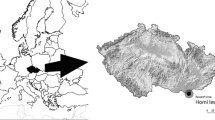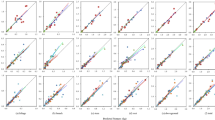Abstract
The purpose of the study is to analyze the productivity and ecological functions of birch and oak stands growing under various anthropogenic influences. The objects of the study are birch and oak stands in permanent test plots of the Forest Experimental District of the Russian State Agrarian University—Moscow Timiryazev Agricultural Academy. It is revealed that oak stands are more productive than birch stands in the conditions of the city of Moscow. The contribution of both tree species to the formation of a positive oxygen balance of cities is approximately the same. Analysis of leaf surface index values shows that crowns of birch stands are capable of retaining more solids suspended in the air than oak stands. To maintain the ecological, aesthetic, sanitary-hygienic, and oxygen-producing functions of stands in the conditions of the city of Moscow, it is necessary to carry out economic measures aimed at the formation of mixed, uneven-aged coniferous- deciduous forests.
Similar content being viewed by others
References
Korotkov, V.N., Taxation characteristics of forest plantations as a reflection of the history of nature management, Monitoring sostoyaniya prirodno-kul’turnykh kompleksov Podmoskov’ya. Yubileynyi sbornik dokladov nauchno-prakticheskoy konferentsii 8–9 sentyabrya 1999 goda (Monitoring of the State of Natural-Cultural Complexes of the Moscow Region. Anniversary Proc. Sci.-Pract. Conf. September 8–9, 1999), Moscow, 2000, pp. 93–101.
Kuz'michev, V.V., Zakonomernosti dinamiki drevostoev: Printsipy i modeli (Patterns in the Dynamics of Forest Stands: Principles and Models), Novosibirsk: Nauka, 2013.
Kiviste, A.K., Funktsii rosta lesa (Forest Growth Functions), Tartu: Est. S-kh. Akad., 1988.
Liepa, I.Ya., Dinamika drevesnykh zapasov: Prognozirovanie i ekologiya (Dynamics of Wood Stocks: Forecasting and Ecology), Riga: Zinatne, 1980.
Shvidenko, A.Z., Shchepashchenko, D.G., Nil’son, S., and Bului, Yu.I., Tablitsy i modeli khoda rosta i produktivnosti nasazhdenii osnovnykh lesoobrazuyushchikh porod Severnoi Evrazii. Normativno-spravochnye materialy (Tables and Models of the Course of Growth and Productivity of Plantations of Principal Forest-Forming Species of Northern Eurasia. Regulatory Reference Materials), Moscow: Fed. agentstvo lesn. khoz., 2006.
Usol'tsev, V.A., Fitomassa i pervichnaya produktsiya lesov Evrazii (Phytomass and Primary Production of Forests of Eurasia), Yekaterinburg: Ural. Otd. Ross. Akad. Nauk, 2010.
Utkin, A.I., Ermolova, L.S., and Utkina, I.A., Ploshchad’ poverkhnosti lesnykh rastenii: Sushchnost’, parametry, ispol’zovanie (Surface Area of Forest Plants: Essence, Parameters, and Application), Vomperskii, S.E., Ed., Moscow: Nauka, 2008.
Author information
Authors and Affiliations
Corresponding author
Additional information
Original Russian Text © N.N. Dubenok, V.V. Kuzmichev, A.V. Lebedev, 2018, published in Rossiiskaya Sel’skokhozyaistvennaya Nauka, 2018, No. 5, pp. 29–31.
About this article
Cite this article
Dubenok, N.N., Kuzmichev, V.V. & Lebedev, A.V. Analysis of Ecological Functions of Birch and Oak Stands in the Conditions of an Urbanized Environment Based on the Materials of Long-Term Observations. Russ. Agricult. Sci. 44, 524–527 (2018). https://doi.org/10.3103/S1068367418060046
Received:
Published:
Issue Date:
DOI: https://doi.org/10.3103/S1068367418060046




